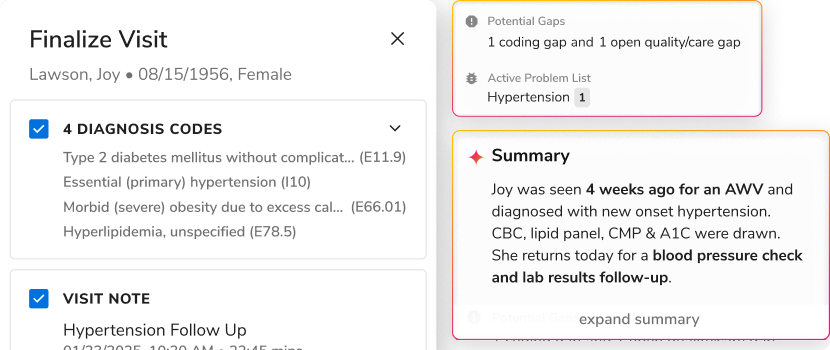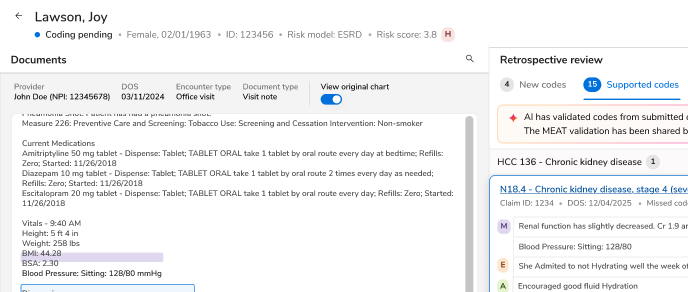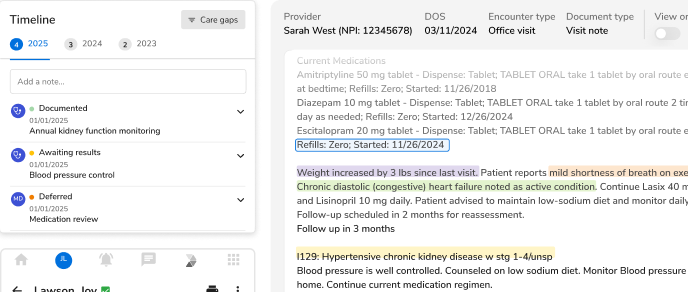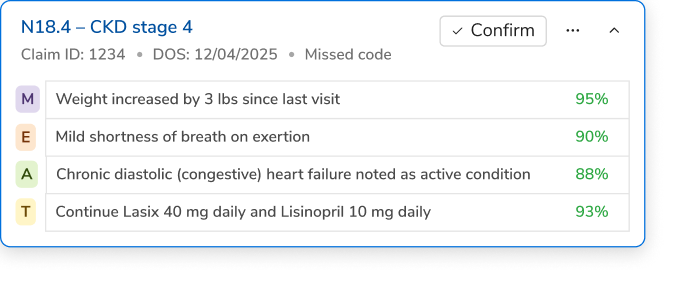Revolutionizing Public Sector Decision-Making: A Deep Dive into Innovaccer's Government Health AI and Analytics Platform (GHAAP)

Medicaid and public health systems face a diverse set of specialized data needs, ranging from population health analysis at the state level to point-of-care requirements at local health jurisdictions. These call for a revolutionary approach to data management and analytics. With global healthcare data projected to grow at an annual rate of 36%, public sector healthcare systems must adopt solutions that can handle massive data influxes while ensuring real-time insights and improved decision-making.
Enter Innovaccer's Government Health AI and Analytics Platform (GHAAP), a groundbreaking solution designed to drive the modernization revolution in Medicaid and Public Health. GHAAP represents a paradigm shift from traditional, siloed systems to a flexible, intelligent, and interconnected data ecosystem. As a leading healthcare AI company and Certified Data Partner for the National Committee for Quality Assurance (NCQA) Data Aggregator Validation program, Innovaccer brings unparalleled expertise to this critical transformation.
GHAAP is not just another data platform; it's a comprehensive solution tailored to the unique challenges of public sector healthcare. By leveraging cutting-edge AI and interoperability standards, GHAAP empowers agencies to make data-driven decisions with unprecedented efficiency and insight. From streamlining Medicaid operations to enhancing public health responses, this platform is set to redefine how government agencies harness the power of their data assets.
In this blog, we'll explore how GHAAP is answering the call for specialized, modular, and modern technology in public sector healthcare, ushering in a new era of data-driven governance and improved health outcomes for communities across the nation.
The Challenge of Data Fragmentation in Public Healthcare
Public sector healthcare organizations face several critical challenges that hinder their ability to leverage data effectively:
- Inaccessible, Siloed Data: The difficulty in accessing and integrating data from various sources impedes comprehensive analysis and decision-making. This is exacerbated by outdated infrastructure in legacy Medicaid Management Information Systems (MMIS), which struggle to integrate with modern healthcare tools and platforms.
- Limited Inter-Agency Collaboration: Barriers to sharing information among different agencies prevent holistic approaches to healthcare. This issue is closely tied to the lack of interoperability in current systems, hindering seamless communication between different components of the healthcare ecosystem.
- Data Security: Protecting sensitive health information across multiple systems remains a paramount concern. With the increasing digitization of healthcare data, modern MMIS solutions must prioritize robust security measures to safeguard patient information.
- Insufficient Social Health Focus: There's a growing need to incorporate social determinants of health into healthcare strategies and interventions. Current systems often lack the flexibility to effectively capture, analyze, and act upon this type of data.
- Privacy Compliance: Keeping pace with rapidly evolving privacy laws and regulations is an ongoing challenge. Systems must be adaptable enough to quickly implement new compliance requirements without disrupting service delivery.
- Scalability and Flexibility Issues: The dynamic healthcare landscape, coupled with exponentially increasing data volumes and processing loads, demands systems that can adapt to changing regulations, healthcare practices, and technological advancements.
- Integration of Emerging Technologies: There's a pressing need to incorporate advanced technologies such as artificial intelligence, telemedicine, and data analytics into healthcare strategies. However, many existing systems are ill-equipped to seamlessly integrate these innovations.
- Limited Data Analytics Capabilities: The ability to leverage advanced analytics to derive meaningful insights from vast amounts of healthcare data is crucial. Upgrading to modern MMIS solutions can empower healthcare providers and policymakers with the information needed to make more informed decisions.
Bridging the Gap: A Next-Generation Data-Driven Approach
The public sector needs to develop a modern, data-driven strategy centered on a data product mindset to address these challenges. This approach means designing and creating data-enabled offerings that consider both business and technical requirements, ultimately solving real-world problems and positively impacting the citizen experience.
According to Gartner, by 2025, 75% of government CIOs will be directly responsible for transforming systems using AI and data analytics. GHAAP’s advanced AI-driven platform is well-suited to support this shift, offering a solution that fits seamlessly into the public sector healthcare space. It enables agencies to centralize and secure data, ensure compliance, facilitate inter-agency collaboration, and incorporate social determinants of health into their decision-making processes. Through these capabilities, GHAAP empowers public sector organizations to transform their data into actionable insights, driving better healthcare outcomes and more efficient operations.
GHAAP: A Comprehensive Solution
Government Health AI and Analytics Platform (GHAAP) represents a paradigm shift in how public sector agencies approach data and analytics. Built on the foundation of Innovaccer's highly effective data and analytics platform, GHAAP addresses the specialized needs of government healthcare organizations, from population health analysis at the state level to point-of-care needs at local health jurisdictions.

Infrastructure and Security: Building the Bedrock of Digital Health Transformation
Any conversation about digital transformation begins with infrastructure. GHAAP recognizes that the technological framework within government agencies must evolve to handle the vast amounts of daily data. Legacy systems, ill-equipped to handle modern data demands, are replaced with cloud-based solutions that support more efficient and flexible data management.
GHAAP's infrastructure is designed with the future in mind, including roadmaps for GovCloud compatibility and MARS-E certification. The platform currently supports both AWS and Azure environments, ensuring flexibility for different agency needs. Compliance is at the forefront of GHAAP's design, with built-in measures to adhere to HIPAA, HITRUST, and 42 CFR Part 2 regulations, providing a secure foundation for sensitive healthcare data.
Unified Data Model for Advanced Analytics
At the core of GHAAP is a unified data model that integrates diverse data sources, creating a comprehensive view of every patient. This model breaks down barriers between different data systems, incorporating Electronic Health Records (EHRs), Health Information Exchanges (HIEs), Social Determinants of Health (SDoH), Homeless Management Information Systems (HMIS), Community-Based Organizations (CBOs), Social Services data, and Medicaid Management Information Systems (MMIS).
By optimizing data analytics and care coordination, data-driven platforms can reduce Medicaid’s administrative costs by up to 25%, potentially saving $20 billion annually.
A key component of this unified model is the Enterprise Master Patient Index (EMPI), a sophisticated system that manages patient identities accurately and efficiently across various departments and systems. The EMPI employs advanced matching techniques, including exact matching of patient demographic attributes and similarity matching using AI and other algorithms like Levenshtein and Damerau-Levenshtein. It also offers special handling for unique cases such as baby names and gender evaluations.

GHAAP's EMPI is highly configurable, allowing agencies to customize the matching process to their specific needs without compromising efficiency. The system includes a robust data cleaning pipeline with specialized cleaners for various data types, ensuring the highest quality of patient data.
Address standardization is another crucial feature of GHAAP's unified data model. Using address standardization, the platform ensures uniformity in address data, which is critical for accurate patient identification and service delivery. This standardization not only improves data quality but also minimizes costs by maintaining a local tenant-level database of standardized addresses for efficient lookup.
Advanced AI Capabilities and Data Governance
GHAAP sets itself apart with its advanced AI capabilities, which are designed to improve predictive analytics, perform what-if analysis, and accelerate model operationalization. At the heart of these capabilities is the AI-powered auto-mapper, which utilizes OpenAI's GPT-4 model to create descriptive expansions of field names. This is complemented by a fine-tuned Llama 3B model specifically tailored for healthcare-specific field mapping.
The platform's natural language support is another standout feature, leveraging NLP, mini-language models, and BERT transformer models. This allows users to create patient cohorts using natural language queries, making complex data analysis accessible to a wider range of users within an agency.
GHAAP also incorporates Mediterm AI, a sophisticated tool for medical terminology management and standardization, ensuring consistent and accurate use of medical terms across the platform. This feature, along with a wide array of ETL (Extract, Transform, Load) connectors, enhances data quality and facilitates seamless integration with various data sources.
GHAAP sets itself apart with its advanced AI capabilities, designed to improve predictive analytics, perform what-if analysis, and accelerate model operationalization. At the heart of these capabilities is the AI-powered auto-mapper, which utilizes OpenAI's GPT-4 model to create descriptive expansions of field names. This is complemented by a fine-tuned Llama 3B model specifically tailored for healthcare-specific field mapping.

Future enhancements to GHAAP's AI capabilities include:
- Generating ER Diagrams to identify relationships between incoming data using GPT-4
- Using Large Language Models (LLMs) to generate sophisticated data quality rules
- AI-powered summarization of dashboards using Sara’s co-pilot capabilities
Case Management
GHAAP includes robust case management capabilities, enabling agencies to efficiently manage individual cases while maintaining a holistic view of each client. The platform consolidates siloed data stores under a single, robust system, streamlining case workflows, program workflows, and necessary reporting. This integrated approach to case management is particularly beneficial for county-level organizations that serve as immediate partners for client assistance.

Data Quality and Governance: Data Pulse
Ensuring data quality and maintaining proper governance are critical aspects of GHAAP. The Data Pulse feature employs advanced techniques to monitor and improve data quality continuously. It uses anomaly detection to monitor data reception timeliness and volumes, learning the expected frequency of data arrivals to identify potential issues quickly.

Data Pulse also incorporates rule-based quality checks across the system, with plans to enhance this using LLMs to generate more sophisticated data quality rules in the future. The feature provides comprehensive data observability capabilities, including:
- Data lineage visualization for understanding data flow and transformations
- Monitoring and alerting systems for proactive issue detection
- Performance tracking and optimization tools
- Logging and audit trails for compliance and troubleshooting
Intelligent Insights with Sara AI
GHAAP differentiates itself further with built-in AI capabilities through Sara AI. This intelligent assistant offers advanced predictive analytics, natural language interfaces for data exploration, and AI-assisted decision support for healthcare professionals. Sara AI leverages the platform's comprehensive data model and advanced analytics capabilities to provide actionable insights, helping agencies make more informed decisions and improve healthcare outcomes.

By combining these powerful features, GHAAP empowers public sector agencies to transform their data into actionable insights, driving better healthcare outcomes and more efficient operations. The platform's comprehensive approach to data management, AI-powered analytics, and interoperability positions it as a game-changer in public sector healthcare IT, enabling agencies to meet the complex challenges of modern healthcare delivery and policy-making.

Interoperability and Data Exchange
Interoperability is at the core of GHAAP's design, supporting seamless data exchange across various systems and agencies. The platform supports over 138 FHIR APIs with USCDI as the profile, ensuring compatibility with a wide range of healthcare data standards. GHAAP also provides compliance support for CMS-9115-F and CMS-0057-F regulations, aligning with the latest regulatory requirements for healthcare data interoperability.
To enhance semantic interoperability, GHAAP partners with Wolters Kluwers for advanced terminology management and Clinical Auto-Mapping. This ensures that medical terms and codes are standardized across different systems and agencies, facilitating more accurate and meaningful data exchange.
The Road Ahead
GHAAP represents a significant leap forward in public sector health IT. By providing a unified, AI-powered platform that addresses the unique challenges of government healthcare organizations, Innovaccer is enabling a new era of data-driven decision-making in the public sector. As agencies continue to modernize their data infrastructure and processes, GHAAP stands ready to support their journey towards more efficient, effective, and equitable healthcare delivery.
To learn more about how GHAAP can transform your agency's data and analytics capabilities, schedule a demo with the Innovaccer team of experts today.

.png)





.png)









.svg)
.svg)

.svg)

